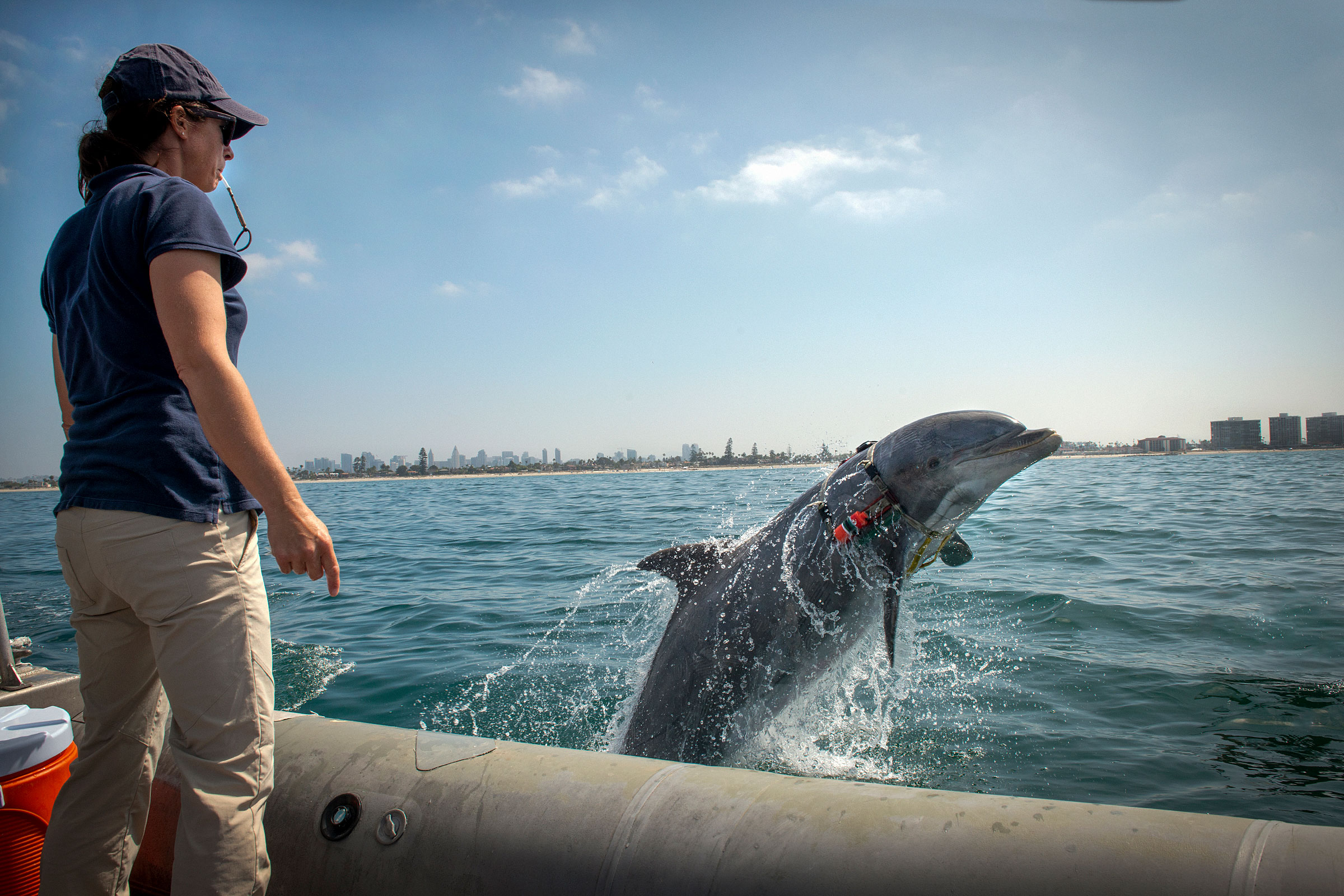A brief history of the US Navy’s dolphins
Dolphin echolocation can find underwater mines more effectively than the best sonar.

- Read our related story on dogs in war
A smattering of blocky white buildings perch at the cut where San Diego Bay meets the Pacific Ocean: Naval Base Point Loma. The complex houses not only hulking warships but also dozens of dolphins, sea lions, and other sea creatures.
The animals are part of the US Navy Marine Mammal Program, which was established in 1959, after scientists found that dolphins were adept at delivering messages and identifying threats underwater. During the Vietnam War, Navy dolphins named Garth, John, Slan, Tinker, and Toad were stationed in Cam Ranh Bay, a deep-water bay in the country’s southeast, to discourage enemy swimmers from attacking a key ammunition pier there.
To avoid predators and locate food, dolphins have evolved extraordinary echolocation abilities. While assessing their underwater environments, they make loud broad-spectrum burst pulses that sound, to humans, like clicks. By listening to the echoes of those clicks, dolphins can detect a three-inch (eight-centimeter) ball from 584 feet—roughly speaking, that’s a tennis ball two football fields away—and distinguish between air gun pellets and corn kernels from 50 feet. They can discern such fine differences even in cacophonous harbors, where man-made sonar has trouble distinguishing between returning echoes and the ambient sounds of boats, waves lapping the shore, and other noises.
These talents, which scientists struggle to fully comprehend, have helped the Navy in more recent wars, too. In 2003, the Navy flew nine of its dolphins to identify mines in Umm Qasr, an Iraqi port on the Persian Gulf—making them the first marine animals to clear mines in a war zone.
Before the dolphins entered the murky waters, the Navy dispatched unmanned sonar drones to map the seafloor. The 80-pound (36-kilogram) machines identified 200 aberrations, according to a 2003 article in Smithsonian magazine, but could not distinguish between threatening objects and innocuous organic ones.
To determine which of the 200 items were cause for concern, the Navy relied on the dolphins of Special Clearance Team One. While their handlers floated nearby in black rubber boats, the dolphins zipped through the water hunting for mines planted by Saddam Hussein’s forces. When they found one, they would alert their handlers by zooming back to the boat and touching a rubber disk with their noses. Then the dolphins would return to the suspected mine and mark it with a tether or acoustic transponder for a diver to disarm later. In a week, the dolphins helped the Navy identify and disable more than 100 anti-ship mines.
Sixteen years on—to the chagrin of some animal-rights groups like PETA, which argue that dolphins do not understand the danger associated with their military work—the creatures look unlikely to be replaced by machines anytime soon.
Even when an undersea mine isn’t obstructed by mud, explains Mark Xitco, the director of the Naval Marine Mammal Program, a sonar system must send out many hundreds of pings, which must then be analyzed to create an accurate picture of the object. A dolphin does the same task in a fraction of a second with a few dozen echolocation clicks. When mines have been buried, the Navy doesn’t even bother with robots; only dolphins are up for the challenge. To Xitco, this is not entirely surprising. “Technology improves every year. We’re making amazing strides,” he reflects. “But dolphins have millions of years of evolution as a head start.”
Haley Cohen Gilliland is a writer in Los Angeles.
Deep Dive
Biotechnology and health
How scientists traced a mysterious covid case back to six toilets
When wastewater surveillance turns into a hunt for a single infected individual, the ethics get tricky.
An AI-driven “factory of drugs” claims to have hit a big milestone
Insilico is part of a wave of companies betting on AI as the "next amazing revolution" in biology
The quest to legitimize longevity medicine
Longevity clinics offer a mix of services that largely cater to the wealthy. Now there’s a push to establish their work as a credible medical field.
There is a new most expensive drug in the world. Price tag: $4.25 million
But will the latest gene therapy suffer the curse of the costliest drug?
Stay connected
Get the latest updates from
MIT Technology Review
Discover special offers, top stories, upcoming events, and more.